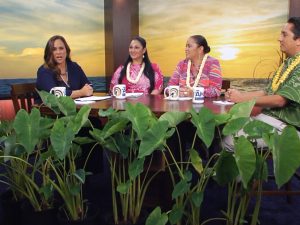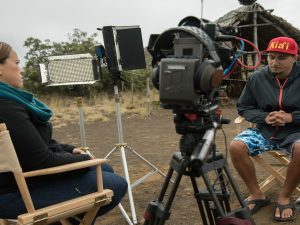Pēlā nō e hoʻomaka ai, ʻike maka i nā waʻa nā kanaka e holo ana, a laila hoʻomaka nā nīnau i loko o lākou “Pehea?” no laila ʻo ko mākou hana ma nā papahana i aʻo ʻia, ʻo ia ka paipai ʻana i nā keiki, [That is how it starts. The kids see for themselves and they become curious. It is our goal to encourage their interests]
Ua lohe mākou no ko Hōkūleʻa lāua ʻo Hikianalia haʻalele ʻana iā Hawaiʻi paeʻāina mai Hilo aku. No laila, ua manaʻo mākou he mea lua ʻole ko kākou, ko mākou hōʻea ʻana i aneʻi, i Palekai e hoʻokipa ai a laila, e hoʻouna aku kekahi me ke aloha. ʻOiai ʻaʻole kākou, nā Hawaiʻi, e launa hou a i kekahi wā lōʻihi. [We heard that Hōkūleʻa and Hikianlia would leave from Hilo. So we thought that it would be awesome to greet and send them off with aloha, since this is the last time we’ll see them for a while], said Mamo Bezilla, a kumu at Ka ʻUmeke Kāʻeo.
“Aʻole ʻo ke kaiāulu ʻo Keaukaha wale nō, akā ʻo ke kaiāulu ʻo Hilo, nā Hilo, Puna kēia moku ʻo Keawe. Akā pōmaikaʻi mākou i ke komo ʻana i loko ʻo kēia hono nei ʻo Palekai no ka mea, pēlā nō e hiki ai iā mākou ke hoʻonaʻauao iā lākou kekahi ma nā inoa ʻāina, nā inoa ua, kēlā mau ʻike i pili i ka ʻāina. [All of Hawaiʻi island is here. We are fortunate that they came into Palekai, because we can then teach the crew about these place names and their cultural significance],” said Keahi Warfield, another kumu at Ka ʻUmeke Kāʻeo.
“It’s just a very very warm community feeling here in Palekai, which this area is known as. It means breakwater but it means to shield you from the sea. So, here in Palekai we are protected, we are nurtured by this community and we are welcomed here by them,” said pwo navigator Kālepa Baybayan.
“Pēlā nō e hoʻomaka ai, ʻike maka i nā waʻa nā kanaka e holo ana, a laila hoʻomaka nā nīnau i loko o lākou “Pehea?” no laila ʻo ko mākou hana ma nā papahana i aʻo ʻia, ʻo ia ka paipai ʻana i nā keiki, [That is how it starts. The kids see for themselves and they become curious. It is our goal to encourage their interests],” said Keahi.
“ʻAʻole loa ia he mea e pau ai ma hope o ka haʻalele ʻana o Hōkūleʻa ka manaʻolana o mākou, e hahai ana mākou i ke kaʻahele ʻana o Hokuleʻa lāua ʻo Hikianalia a puni ka honua. [Itʻs not something that will end when Hōkūleʻa leaves. We hope to track Hōkūleʻa and Hikianalia as they navigate around the world],” said Mamo.



